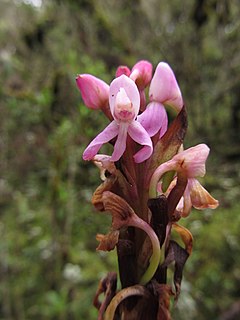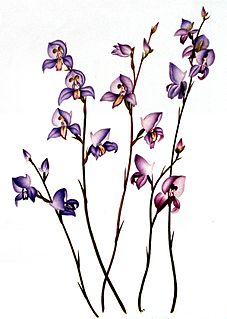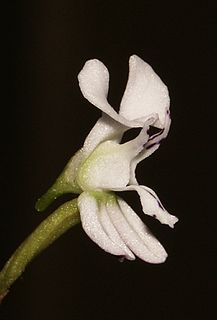
Magnolia is a large genus of about 210 to 340 flowering plant species in the subfamily Magnolioideae of the family Magnoliaceae. It is named after French botanist Pierre Magnol.

The family Campanulaceae, of the order Asterales, contains nearly 2400 species in 84 genera of herbaceous plants, shrubs, and rarely small trees, often with milky sap. Among them are several familiar garden plants belonging to the genera Campanula (bellflower), Lobelia, and Platycodon (balloonflower). Campanula rapunculus and Codonopsis lanceolata are eaten as vegetables. Lobelia inflata, L. siphilitica and L. tupa and others have been used as medicinal plants. Campanula rapunculoides may be a troublesome weed, particularly in gardens, while Legousia spp. may occur in arable fields.

Disa is a genus of flowering plants in the family Orchidaceae. It comprises about 182 species. Most of the species are indigenous to tropical and southern Africa, with a few more in the Arabian Peninsula, Madagascar, and Réunion. Disa bracteata is naturalised in Western Australia, where the local name is "African weed-orchid."

Prosopis juliflora is a shrub or small tree in the family Fabaceae, a kind of mesquite. It is native to Mexico, South America and the Caribbean. It has become established as an invasive weed in Africa, Asia, Australia and elsewhere. It is a contributing factor to continuing transmission of malaria, especially during dry periods when sugar sources from native plants are largely unavailable to mosquitoes.

Xi Draconis is a double or binary star in the northern circumpolar constellation of Draco. It has an apparent visual magnitude of 3.75. Based upon parallax measurements, it is located at a distance of 112.5 light-years from the Sun. At this distance, the apparent magnitude is diminished by 0.03 from extinction caused by intervening gas and dust.

Disa stairsii is a species of Disa of the family Orchidaceae that can be found growing with the giant heathers on the Rwenzori Mountains of mountains in East Tropical Africa as well as in the Congo in West-Central Tropical Africa.

Disa cardinalis is a species of orchid found in South Africa.

Disa cernua is a species of orchid found in South Africa, in Eastern Cape and Western Cape provinces.

Disa cornuta is a species of orchid found from Zimbabwe to South Africa.

Disa purpurascens is a species of orchid found in South Africa. It is also known as the early blue disa or the bloumoederkappie.

Disa sagittalis is a species of orchid found in South Africa from south and southeast Cape Province to southern KwaZulu-Natal.

Disa tripetaloides is a species of orchid that grows along the edges of streams in South Africa. This is one of the smaller species in the genus Disa in the section Disa. There are populations that come from the winter-rainfall areas of South Africa, and summer-rainfall areas of South Africa.
Disa borbonica is a species of orchid in the Orchidaceae family. It is endemic to Réunion.

Disa graminifolia is a species of orchid found in the Cape Floristic Region of South Africa.

Disa ferruginea is a stout, reed-like terrestrial 200–450 mm tall. Radical leaves linear, developing after flowering; cauline leaves dry, sheathing. Inflorescence dense, 1–40 flowered. Flowers bright red to orange, often with some parts yellow. Median sepal apiculate, galea 8–10 mm deep; spur slender, grading into the galea, 7–20 mm long; lateral sepals projecting away;elliptic to narrowly elliptic, with apiculi up to 4 mm long;petals spear-shaped, 5–7 mm long; lip narrowly egg- to spear-shaped, 10–12 mm long.

Disa virginalis is a species of orchid found in Southwest Cape Province, South Africa.
Disa intermedia is a species of orchid, native to Eswatini, formally Swaziland.














